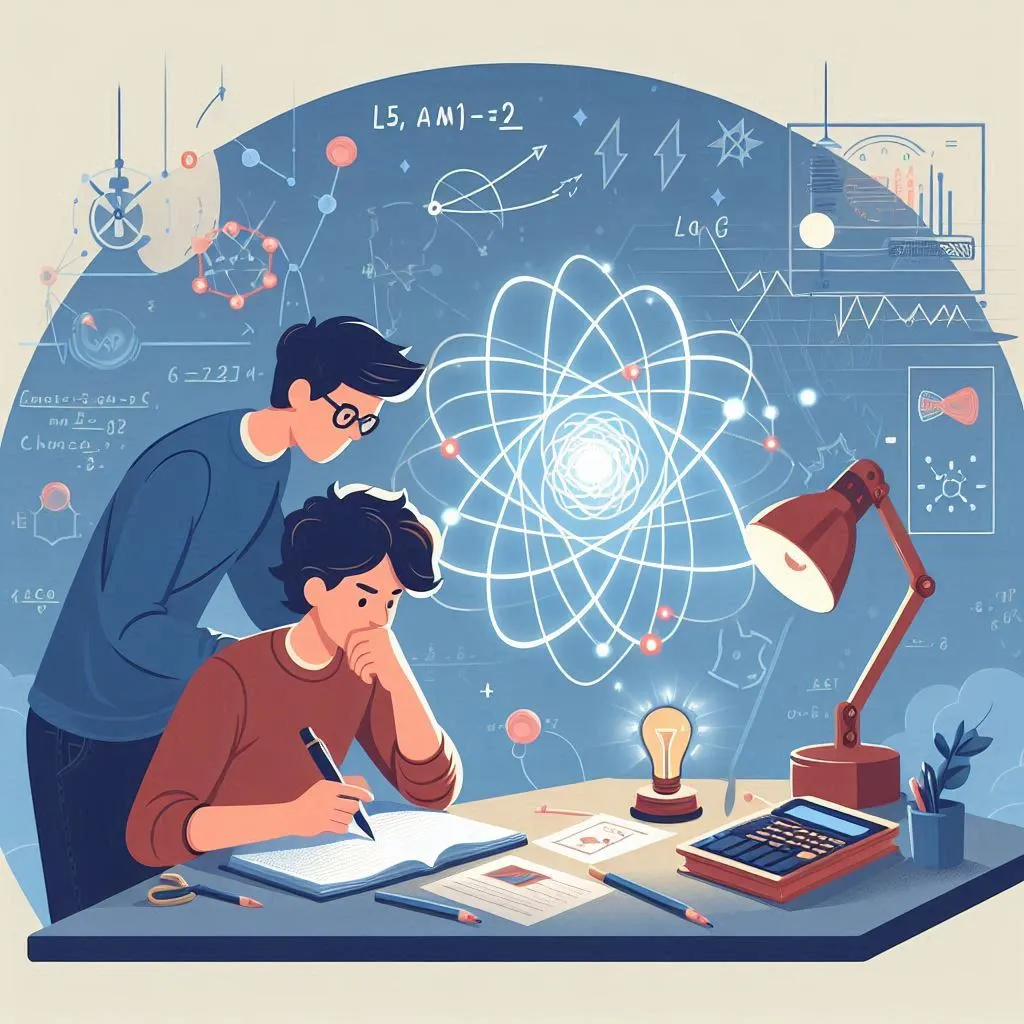Quantum mechanics stands as a cornerstone of Electrical Engineering, offering a profound exploration into the behavior of particles at the fundamental levels of existence. It delves into a realm where classical intuition falters, demanding a unique blend of theoretical insight, mathematical rigor, and strategic problem-solving abilities from students. The mastery of quantum mechanics assignments thus becomes a significant academic challenge, necessitating a structured approach to navigate its complexities effectively. At its core, quantum mechanics unveils a universe where particles exhibit both wave-like and particle-like behaviors, challenging our classical notions of determinism and predictability. Electromagnetism Assignments often revolve around grasping foundational concepts such as the particle nature of light, elucidated by Einstein's work on the photoelectric effect and the subsequent development of quantum electrodynamics. Compton scattering further exemplifies these dualities, where photons interact with electrons in a manner that reflects both wave propagation and discrete particle exchanges. Understanding these quantum mechanical principles will be crucial for effectively applying them to the study of electromagnetic fields and interactions.

The Heisenberg uncertainty principle emerges as another pivotal concept, emphasizing the intrinsic limits of precision in simultaneously measuring complementary variables such as position and momentum. This principle, formulated by Werner Heisenberg, underscores a fundamental characteristic of quantum systems, setting a boundary to our classical notions of definiteness and prompting a probabilistic interpretation of nature. Probability distributions form a critical toolkit in quantum mechanics, serving as the bridge between the probabilistic wave functions describing quantum states and observable outcomes. These distributions, often represented by complex mathematical formalisms like the Schrödinger equation or matrix mechanics, encapsulate the probabilistic essence of quantum phenomena. Navigating through quantum mechanics assignments demands more than rote problem-solving; it necessitates a holistic understanding of these principles. This guide aims to empower students with a strategic toolkit to tackle such challenges systematically. By cultivating a deep comprehension of fundamental principles and honing problem-solving skills through structured practice, students can transcend the inherent complexities of quantum mechanics assignments.
Particle Nature of Light
The particle nature of light, elucidated by quantum mechanics, posits that light consists of discrete packets of energy called photons. Each photon carries energy proportional to its frequency, as described by Planck's constant. This concept revolutionized physics by explaining phenomena like the photoelectric effect and Compton scattering, where light interacts with matter as discrete particles. Understanding light's dual wave-particle nature is fundamental in fields from optics to quantum computing, shaping our comprehension of the universe at microscopic scales.
Understanding Photon Flux from Sunlight
In quantum mechanics, light is quantized into photons, each carrying specific energy related to its wavelength. For instance, sunlight delivers substantial power to the Earth's surface, which can be quantified in terms of photon flux using Planck's constant and the wavelength of light. By calculating how many photons strike a square meter of the Earth's surface per second during daylight hours, students gain insights into the energy transfer mechanisms crucial for understanding solar energy applications and theoretical physics.
Solar Sail Propulsion
Exploring futuristic concepts like solar sails involves understanding momentum transfer through photon interactions. Whether photons are reflected or absorbed by the sail significantly impacts the energy transfer per photon and, consequently, the force exerted on the sail. By analyzing these interactions and calculating solar pressure on a hypothetical solar sail, students engage with real-world applications of quantum mechanics principles, enhancing their grasp of photon behavior and momentum conservation laws.
Compton Scattering
Compton scattering is a fundamental phenomenon in quantum mechanics where photons collide with electrons, resulting in the scattering of the photon at a different wavelength and the recoil of the electron. This process demonstrates the dual wave-particle nature of light and confirms Einstein's hypothesis on the quantization of light energy. Compton scattering plays a crucial role in various fields, from medical imaging using X-rays to understanding the interaction of light with matter in astrophysics and quantum mechanics research.
Measuring Electron Velocity
Compton scattering experiments offer a practical way to measure electron velocities by analyzing the scattering of photons off electrons. This technique involves precise timing measurements and considerations of energy and momentum conservation laws. By interpreting how photons interact with electrons and calculating resultant changes in electron velocities, students deepen their understanding of particle dynamics and experimental methodologies used in quantum mechanics research.
Quantifying Momentum Transfer
During Compton scattering, photons transfer momentum to electrons, altering their trajectories and velocities in predictable ways. By quantifying the momentum transfer per photon and examining angles of incidence and reflection, students explore fundamental principles governing particle interactions. This section emphasizes the practical application of momentum conservation laws and highlights the role of photon energy in influencing electron behavior, crucial for both theoretical understanding and experimental design in quantum mechanics.
Analyzing Uncertainty and Energy Spread
Every measurement in quantum mechanics introduces uncertainty, necessitating careful analysis of photon momentum uncertainties and their implications for electron velocity measurements. Moreover, characteristics of photon pulses—such as their duration and energy distribution—affect the precision of energy measurements in Compton scattering experiments. By examining these uncertainties and energy spreads, students develop critical thinking skills essential for interpreting experimental data and advancing their understanding of quantum phenomena.
Heisenberg Uncertainty Principle
The Heisenberg Uncertainty Principle, a cornerstone of quantum mechanics, asserts that it is impossible to simultaneously and precisely determine certain pairs of complementary properties of a particle, such as its position and momentum. This principle highlights a fundamental limit in our ability to measure and predict the behavior of quantum systems, revealing the inherently probabilistic nature of particles at the microscopic level. It fundamentally reshaped our understanding of physics by challenging classical notions of determinism and paving the way for the development of quantum theory.
Exploring the Infinite Potential Well
The Heisenberg uncertainty principle dictates that certain pairs of physical properties—such as position and momentum—cannot be precisely determined simultaneously. Within an infinite potential well, where particles are confined within a defined space, quantum mechanics predicts discrete energy levels and probability distributions. Comparing classical probability distributions with quantum counterparts provides insights into how confinement affects particle behavior and the inherent limitations imposed by quantum theory.
Quantifying Uncertainty
Quantifying uncertainty in position and momentum measurements illuminates the probabilistic nature of quantum systems and the mathematical expressions governing particle behavior within confined spaces. By calculating uncertainties and their respective products, students deepen their understanding of quantum mechanical principles and their applications in experimental physics. This section underscores the foundational importance of uncertainty principles in quantum mechanics and their implications for experimental design and data interpretation.
Tips for Successful Problem Solving
Excelling in solving electrical engineering assignments requires a strategic approach and adherence to best practices. Here are several key tips to help you achieve success:
Understand the Concepts
A strong grasp of fundamental concepts is the cornerstone of effective problem-solving. It is essential to spend ample time reviewing theoretical principles. Ensure you comprehend how these principles apply to various practical problems.
Show All Steps
When tackling complex assignments, it is crucial to clearly document each step of your calculations. Writing out all steps serves multiple purposes. Firstly, it helps you track your progress and maintain a logical flow. Secondly, detailed documentation makes it easier to identify and correct mistakes.
Use Consistent Units
Maintaining consistency in units throughout your calculations is vital to avoid errors and achieve accurate results. Electrical engineering problems often involve various units, such as volts, ohms, amperes, and watts. Converting units appropriately and ensuring consistency can prevent mistakes that arise from unit discrepancies.
Check Your Work
Thoroughly reviewing your calculations is a key step in ensuring accuracy. After completing a problem, take the time to double-check your work. Verify each calculation, re-evaluate key steps, and ensure that your final answers make sense in the context of the problem.
Practice Regularly
Regular practice is indispensable for mastering problem-solving skills. Working on a variety of problems helps you build confidence and proficiency. By exposing yourself to different types of problems, you can identify patterns and develop strategies for tackling similar issues in the future. Consistent practice also helps reinforce theoretical knowledge and improve your ability to apply concepts in practical scenarios.
Advanced Problem-Solving Strategies
For more complex problems, advanced strategies can be helpful. Here, we explore some techniques to tackle challenging assignments.
Dimensional Analysis
Dimensional analysis involves checking the consistency of units throughout a calculation. It helps identify errors and ensures that equations are applied correctly.
Approximation Techniques
In some cases, exact solutions may be difficult to obtain. Approximation techniques can provide reasonable estimates that simplify the problem-solving process.
Numerical Methods
For problems that cannot be solved analytically, numerical methods offer a way to find approximate solutions using computational techniques. Familiarity with software tools and programming languages can be beneficial.
Conclusion
Mastering quantum mechanics assignments demands a blend of dedication, critical thinking, and a deep understanding of both theoretical concepts and mathematical tools. This guide emphasizes key strategies essential for success in this complex field. Firstly, comprehending the particle nature of light and delving into experiments like Compton scattering lays a foundational understanding. Secondly, grappling with the profound implications of the Heisenberg uncertainty principle sharpens analytical skills crucial for quantum mechanics. Furthermore, interpreting probability distributions reinforces the statistical basis integral to quantum phenomena.
These strategies not only provide theoretical insights but also cultivate practical skills vital for advanced physics studies. Each topic covered serves as a stepping stone towards navigating the intricate landscapes of quantum mechanics assignments with confidence. By engaging with these methodologies, students not only enhance their academic prowess but also prepare themselves for real-world applications in physics research and innovation. Ultimately, mastering quantum mechanics equips individuals to contribute meaningfully to the ongoing exploration of the fundamental principles that govern the universe, fostering both personal growth and scientific advancement in equal measure.
